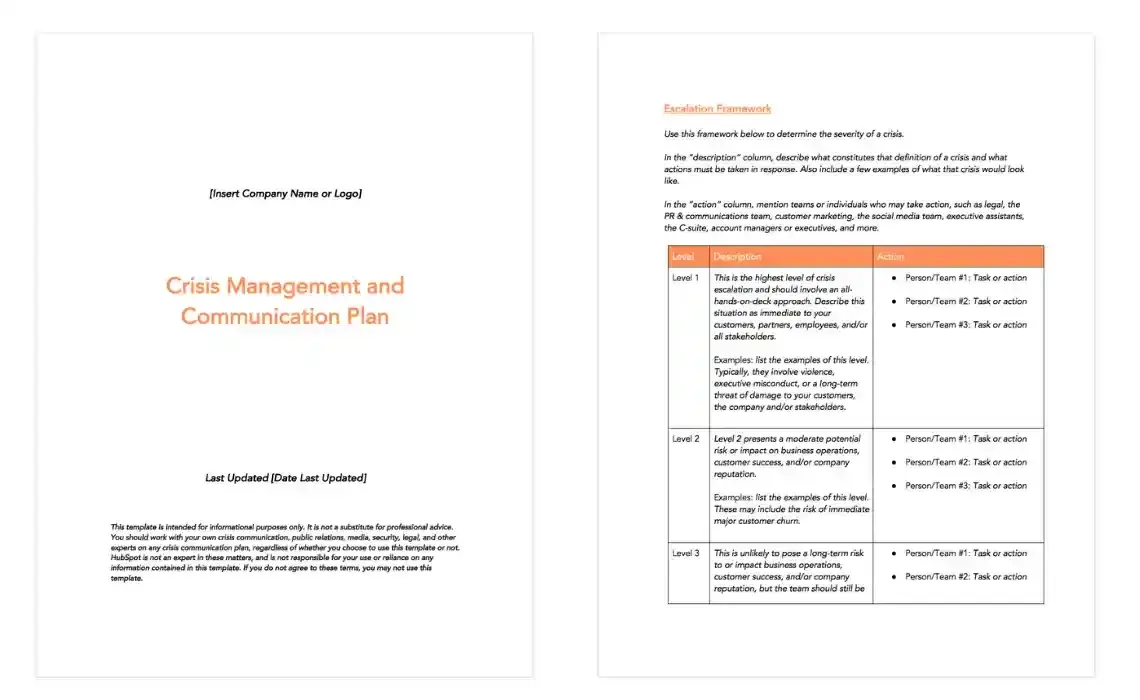In this guide, I’ll show you how to create a communication framework that protects your reputation, maintains stakeholder trust, and confidently navigates any crisis that comes your way.
Table of Contents
- What is crisis communication?
- What is a crisis management plan?
- Crisis Communication Plan Examples
- Why is a crisis management plan important?
- Crisis Management Strategies
- How to Write a Crisis Communication Plan
- What to Include in a Crisis Management Plan
- The Crisis Management and Communication Plan Template
What is crisis communication?
Crisis communication is how your company responds when disaster strikes and your reputation is on the line. It involves issuing media statements, customer updates, and stakeholder outreach.
“Crisis management is always first and foremost about people,” says John Bailey, senior VP at GoCrisis.
“Focus on the harm done and calibrate your response to that — whether it's a customer who bought a product that went wrong, or somebody who lost a loved one.”
Whether you actively manage it or not, your company's reputation is already established in the minds of those familiar with your brand.
While researching corporate responses to crises, I realized that taking control of crisis communication allows you to shape the narrative rather than letting others define it for you.
By communicating openly during challenging times, you safeguard your reputation and foster deeper customer trust through transparency.
Now, you might be wondering, “What constitutes a crisis?” Let's dive into some examples below.
Crisis Scenario Examples
Just about any scenario could manifest as a business crisis that warrants communication from your organization.
“You can almost guarantee that the day the bell rings and something really significant happens, it will be the one thing you never considered,” says Bailey, citing how a volcanic eruption in Iceland disrupted operations at Singapore's Changi Airport — a scenario that scored so low on their risk register that it had never been considered.
Some of the most common types of crises include:
- Financial. Financial loss such as announcing a bankruptcy or store closures.
- Personnel. Staff changes that may affect operations or reputation such as employee furloughs, layoffs, or controversial behavior.
- Organizational. Misconduct or wrongdoing as a result of organizational practices.
- Technological. Technological failure that results in outages causing reduced functionality or functionality loss.
- Natural. Natural crisis that necessitates an announcement or change of procedure. For example, defining safety precautions amid a health crisis.
- Confrontation. Discontent individuals confront an organization as a result of unmet needs or demands.
- Workplace violence. Violence is committed by a current or former employee against other employees.
- Crisis of malevolence. A business uses criminal or illegal means to destabilize, harm, extort, or destroy a competitor.
In addition, anything else you can think of that could stall or halt business continuity is a good example of a crisis that warrants communication with customers and/or the public.
While crisis communication can be fairly reactive, it helps to have a crisis communication plan in place before you need to use it to make the process easier for your team members.
What is a crisis management plan?
A crisis management plan is a detailed strategy designed to guide an organization in preparing for, responding to, and recovering from unexpected and potentially disruptive events.
While reviewing different crisis management plans, I've discovered that the best ones do more than just list procedures – they serve as a structured framework to minimize the impact of crises, safeguard stakeholders, and ensure operational continuity.
Most importantly, a crisis management plan helps guarantee a quick release of information and a consistent message on all company platforms during a crisis. That message depends largely on what the crisis involves and how all parties are affected by it.
Why is a crisis management plan important?
At this point, you might be thinking: "A crisis management plan? That sounds like a lot of work for something we might never use. What's the point?"
In reality, how you prepare for and respond to a crisis plays a major part in whether your organization survives it. According to Capterra's 2023 Crisis Communications Survey, fewer than half (49%) of U.S. businesses have a formal documented plan.
Specifically, having a solid crisis management plan helps you:
Act swiftly when minutes matter.
During a crisis, your team might have to make dozens of critical decisions simultaneously. It could be facing cyberattacks, technology failures, or workplace violence — and that's just the beginning.
Having to figure out your response in the moment is like attempting to build a lifeboat during the storm.
That’s why Carmel O'Toole, a seasoned journalist and award-winning PR practitioner, advises that “a holding statement should be issued within the first few moments. It doesn‘t need to say a lot, but it’s about establishing your organization as a central point of authoritative communication."
Protect your reputation.
The first 24 hours often determine how your organization's response will be remembered.
A crisis management plan ensures quick, consistent, and transparent communication, which explains why 84% of leaders who've experienced a crisis say they would increase practice sessions afterward.
“Resources are finite,” O'Toole advises, “so focus on the most likely scenarios. Do a risk assessment — look at both likelihood and potential impact to prioritize your crisis planning.”
Keep your team aligned.
A crisis management plan ensures everyone knows their exact role and responsibilities. As O'Toole emphasizes, “Who handles media communications? Who manages operational continuity? Who coordinates with emergency services?”
These aren't questions you want to be asking in the middle of a crisis.
Your team members are also your most important ambassadors. “Staff should not be last in line to hear about what's going on,” she notes.
While it‘s important to have media policies in place, this shouldn’t be treated as a gag order — it's about ensuring inquiries are directed to the proper channels and that everyone can respond confidently and consistently.
When these roles and responsibilities are clearly defined, your organization can respond as a unified front rather than scattered individuals.
This coordinated approach makes all the difference when time is of the essence and every decision counts.
Crisis Management Strategies
1. Spokesperson Response
In my analysis of corporate apologies during crises, I've found that humanizing the response — whether through a CEO statement or designated spokesperson — consistently leads to better outcomes than technical or legal-focused responses.
“Ignore the noise and focus on what you own as a responsibility,” advises Bailey, drawing from his experience leading Malaysia Airlines' communications during the MH370 incident. “The first currency that you have in a crisis is information,” he adds.
Choosing a good communicator is important, as their actions will influence how your key stakeholders react to the situation. If they can make your company look human and your mistakes appear manageable, that will play a major role in maintaining stakeholder support.
2. Proactive Damage Control
When examining cases where companies have successfully avoided potential crises, I've noticed that systematic preparation is the key factor differentiating containment from catastrophe.
In my research on cybersecurity incidents, companies that invested in preventive measures consistently achieved better crisis outcomes than those that were forced into reactive responses.
Proactive damage control is what you do to reduce or prevent the effects of a crisis before it occurs. For example, adding security software that records and backs up company data will help you avoid a malware crisis. Additionally, you can train your employees to watch out for suspicious or harmful emails that might reach their inboxes.
At HubSpot, our security team sends out routine training videos to educate employees about different security protocols. The videos are short and the multiple-choice quizzes are so light-hearted that they act as additional learning tools in case you didn't pay close attention to the video.
This makes training easy to consume and, more importantly, effective in teaching employees how to protect company data.
3. Case Escalation
Sometimes, crises can be resolved on the individual level before they reach a viral tipping point. For these cases, it helps to create an escalation system within your customer service team that can diffuse the issue before it gets out of hand.
At HubSpot, we have specialists who work on complex or time-sensitive cases. When customers have needs that require additional attention, our experts intervene to assist. This helps the service rep manage a tricky situation and ensures a more delightful experience for our customers.
4. Social Media Response
In analyzing how companies respond to crises on social media, I've observed an interesting pattern: the speed of information sharing on social platforms can transform a minor incident into a major crisis before a company can react.
What makes social media particularly challenging for crisis management is its dual nature: while it's a powerful marketing tool that allows companies to reach audiences across the globe, this reach works both ways.
Customers can share stories, post pictures, and upload videos for the world to see. One viral video painting your company in the wrong light can lead to millions of people developing a negative perception of your brand.
Crises are battled both in-person and online. So, your company needs a social media plan that can manage the digital buzz around your business.
This may include assigning more reps to monitor your social channels or updating followers with new information. But, regardless of how you use it, social media can't be ignored when your company is working through a crisis.
5. Customer Feedback Collection and Analysis
Sometimes, a crisis occurs, but it isn‘t on the front page of the news or going viral on social media. Instead, it’s silently affecting your customers and causing churn, but you‘re unaware of it because you’re not gathering enough feedback from your customers.
Gathering feedback is an excellent way to prevent a crisis. It provides insight into how customers are feeling about your business, allowing you to spot major roadblocks before they escalate into a crisis. Customers can also share negative criticism that you can use to improve other customers' experiences.
When faced with an unhappy or escalated customer, our success team recognizes this as a chance to collect customer feedback. They begin interactions by asking customers to review their experience and discuss any unsatisfactory elements. This helps our team create actionable steps that they can use to align themselves with the customer's needs.
Rachel Grewe, a HubSpot Customer Success rep, explains this strategy in the quote below.
“I open with asking for the opportunity to hear their feedback on their experience, then I make sure to close with actionable next steps for myself and the customer. An escalated customer isn't always a sign of failure but an opportunity to demonstrate our commitment to our customer's success.”
How to Write a Crisis Communication Plan
“If something happens that brings consequences for you as a business, that thing has already happened. You can't turn the clock back,” says Bailey.
With this consequences-first mindset, here's how to create your crisis communication plan.
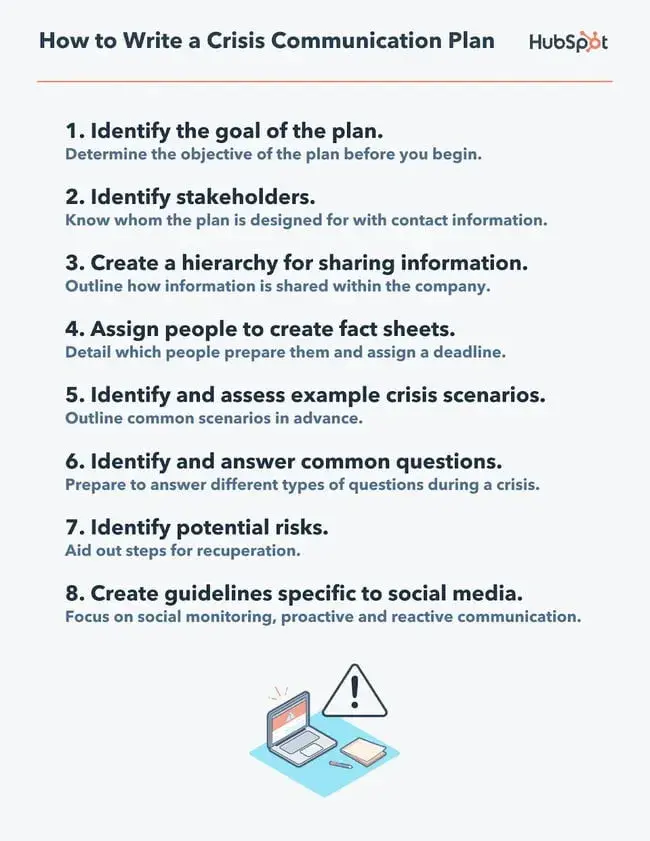
1. Identify the goals of the plan.
I recommend focusing your crisis communication plan on specific, measurable outcomes rather than just broad goals.
The goal of a crisis communication plan is to ensure rapid, transparent, and unified messaging that protects the organization’s reputation, restores trust, and maintains operational continuity.
For example, in a product recall scenario, the objective might include achieving a 90% resolution rate within 48 hours while minimizing negative sentiment by 30% on social platforms.
To measure success, establish clear metrics such as response time, stakeholder engagement levels, and recovery benchmarks that align with the organization’s strategic priorities.
2. Identify stakeholders.
Effective crisis communication begins with stakeholder identification and prioritization.
Stakeholders should be segmented into primary and secondary groups based on their level of impact and influence.
For example:
- Primary stakeholders. Customers affected by service disruptions, employees managing crisis operations, and investors requiring reassurance about the company’s stability.
- Secondary stakeholders. Media outlets monitoring the story, regulators overseeing compliance, and industry partners dependent on the company’s operations.
Use a prioritization framework to guide communication flow.
For instance, during a major outage, customers and employees need immediate updates, while media statements can follow after internal alignment. Tailor messaging to each group’s needs: investors may require data on financial impact and recovery timelines, while customers need actionable next steps to resolve their concerns.
Additionally, maintain a centralized database of stakeholder contact information and communication preferences. This ensures rapid outreach and minimizes delays during high-pressure situations.
3. Create a hierarchy for sharing information on the crisis.
Establishing a clear hierarchy for sharing information ensures timely and accurate communication during a crisis.
I think the most critical aspect here is ensuring no information gets lost between teams.
This hierarchy should adapt to the nature of the crisis and account for backup roles to avoid delays.
A typical structure might include:
- Initial reporting. The first person to identify the crisis (e.g., a customer service agent noticing a social media backlash) escalates it to their direct manager.
- Leadership notification. Department heads evaluate the situation and notify the Crisis Response Lead (e.g., COO or Head of Communications) with all available details.
- Cross-functional coordination. The Crisis Response Lead convenes a task force, which may include the CEO, General Counsel, and department heads, depending on the crisis type.
- External experts. For high-stakes situations, legal advisors, PR consultants, or cybersecurity firms are brought in to provide expertise.
For example, in a cybersecurity breach, the IT team identifies the issue and escalates it to the CTO. The CTO notifies the Crisis Response Lead, who activates the plan, including contacting legal counsel for regulatory reporting requirements and the PR team for stakeholder communication.
Ensure all roles in the hierarchy are well-documented, with designated backups to handle absences. Clearly outline decision points, such as “Media statements require CEO sign-off within one hour of draft completion,” to maintain alignment.
4. Assign people to create fact sheets.
Assigning the right team to create fact sheets is critical for maintaining accurate and consistent messaging. Fact sheets should outline key details, such as the nature of the crisis, its impact, and immediate next steps, tailored to the intended audience.
In my view, fact sheets work best when they anticipate stakeholder questions rather than just stating company positions.
To streamline this process, focus on:
- Roles and responsibilities. Assign a content lead to draft the document, a subject matter expert to ensure accuracy, and an approval lead to finalize it. For example, in a data breach scenario, the IT team provides technical details while the PR team adapts them into an accessible language for customers.
- Templates and tools. Use pre-designed templates or crisis management software to ensure clarity and speed. Fact sheets for media might include a concise incident summary and approved quotes, while enterprise clients may require a detailed timeline and resolution roadmap.
- Timeline management. Set deadlines based on crisis urgency. For instance, during a service outage, prepare a fact sheet within 30 minutes for internal use, with a customer-facing version ready within 2 hours.
- Real-time updates. Fact sheets should be living documents that evolve as new information becomes available. Proactively update stakeholders to prevent misinformation and build trust.
For example, during a service disruption, the initial fact sheet might confirm the outage and estimated resolution time. As the investigation progresses, updates can include the root cause, recovery actions, and steps to prevent recurrence.
5. Identify and assess example crisis scenarios.
Identifying and assessing potential crisis scenarios allows your organization to prepare for high-impact events proactively.
Start by creating a list of likely scenarios relevant to your business and assessing them using a likelihood-impact matrix. This approach prioritizes your response plans based on the probability of occurrence and the potential damage to your organization. Below are some potential scenarios.
- Cybersecurity breach: A hacker gains access to customer data, triggering regulatory reporting requirements and public concerns about data privacy.
- PR scandal: An executive’s controversial comment goes viral, leading to calls for accountability on social media and demands for a public apology.
- Operational failure: A major service outage disrupts customer operations during peak business hours, resulting in financial losses and reputational damage.
For each scenario, outline potential impacts (e.g., regulatory penalties, customer churn) and craft tailored mitigation strategies.
For instance, in a cybersecurity breach, your response plan should include immediate containment steps, regulatory disclosures, and customer communication templates.
Collaborate across teams to build robust scenario assessments. Legal teams can provide insights into regulatory risks, IT teams on operational vulnerabilities, and PR teams on reputational threats. Regularly revisit and update these scenarios based on changes in your business or industry trends.
6. Identify and answer common questions.
During any crisis — no matter how big or small — people are going to ask questions. Whether they are customer advocates or reporters, the public will want to uncover the truth. After all, in most cases, companies are seen as guilty until proven innocent.
Crisis communication plans can help you identify and answer questions that you can expect to be asked during your crisis scenarios.
Pro tip: I suggest building your Q&A document based on actual stakeholder concerns rather than assumptions. Use the potential scenarios you identified to structure this doc.
You can also collaborate across teams to build robust scenario assessments. Legal teams can provide insights into regulatory risks, IT teams on operational vulnerabilities, and PR teams on reputational threats.
Regularly revisit and update these scenario responses based on changes in your business or industry trends.
7. Identify potential risks.
Identifying potential risks is essential to prepare for the challenges your crisis communication plan may face. Based on my analysis, effective risk identification requires thinking beyond immediate operational concerns.
Start by categorizing risks into key areas such as:
- Operational risks. Delayed responses or misinformation spreading internally.
- Reputational risks. Loss of customer trust due to inadequate communication or slow action.
- Legal and regulatory risks. Non-compliance with disclosure requirements or breaches of contractual obligations.
- Financial risks. Increased costs due to service recovery or customer churn.
Use a risk probability-impact grid to assess and prioritize risks. For example, a cybersecurity breach might have a low likelihood but high impact, requiring proactive contingency plans.
Develop pre-approved mitigation frameworks for high-risk scenarios. For instance, in a PR crisis, your framework might include immediate coordination with legal counsel to vet public statements or pre-drafted customer communication templates.
Understand cascading risks, where one issue triggers others. A data breach, for instance, may lead to legal fines, customer dissatisfaction, and a drop in stock value. Addressing the root cause swiftly can prevent secondary risks from escalating.
Finally, perform a post-crisis analysis to identify gaps in your risk management strategy and incorporate lessons learned into your plan. This continuous improvement process ensures your organization is better prepared for future crises.
8. Create guidelines specific to social media.
Social media is often the front line in crisis communication, requiring swift, transparent, and platform-specific responses. I've found that social media requires its own distinct crisis response framework due to its real-time nature.
Here's what I recommend to manage a crisis effectively.
- Tailor your messaging for each platform. For example:
- Use concise, real-time updates for X, focusing on key facts and reassurances.
- Maintain a professional tone on LinkedIn for updates aimed at investors and partners.
- Adopt a customer-centric and empathetic approach for Instagram or Facebook audiences.
- Deploy tools like Hootsuite or Sprout Social for continuous monitoring of mentions, hashtags, and keywords related to the crisis. Use AI-driven sentiment analysis to detect trends and adjust your messaging accordingly.
- Leverage relationships with trusted influencers or brand advocates to share accurate information and counter misinformation.
- Establish a rapid response team dedicated to identifying and addressing false narratives before they gain traction. For example, correcting viral misinformation with pinned posts or official replies.
- Ensure messaging across platforms is empathetic and transparent while reflecting the brand’s voice. Avoid overly formal responses on customer-focused platforms and overly casual tones on professional networks.
- Provide consistent updates at predictable intervals (e.g., every hour for fast-evolving crises). Avoid overwhelming your audience with excessive posts while ensuring you remain visible and accessible.
Pro tip: During a service outage, post real-time updates on X every 30 minutes, while using LinkedIn for a professional incident summary and estimated resolution timeline. Proactively address customer inquiries on Instagram and Facebook with pre-approved FAQs tailored to the crisis.
What to Include in a Crisis Management Plan
If the idea of crafting a crisis management plan feels overwhelming, take a deep breath — it’s more manageable than it sounds. And the payoff? A roadmap that helps you navigate stormy seas with confidence.
A strong plan ensures your team can act decisively, communicate effectively, and stay aligned when it matters most. Here’s what to include.
1. Crisis Response Team
Think of this as your organization’s emergency task force. Who’s taking the lead? Who’s the backup? And who’s handling media inquiries? These roles should be crystal clear.
“Your spokesperson should embody the Five C’s: Clarity, control, concern, confidence, and competence,” O'Toole advises.
Make sure contact details are up-to-date so there’s no scrambling when minutes count.
2. Communication Protocols
When a crisis hits, everyone — from employees to customers — needs clear, consistent information. Outline who communicates what and how, from pre-approved templates to specific messaging channels.
“Transparency is key,” O'Toole explains. “Pre-planning helps maintain trust while avoiding missteps in the heat of the moment.”
3. Emergency Response Procedures
No one wants to figure out evacuation plans or safety protocols on the fly. Document these steps ahead of time, and keep holding statements ready to issue within minutes. Preparation now saves precious time later.
4. Business Continuity Measures
Crises can disrupt operations — but they don’t have to derail them. Detail how your organization will keep critical functions running, from backup systems to recovery procedures.
“Think beyond the basics,” O'Toole suggests. “What happens if your primary systems fail? Do you have backup tools to keep critical systems up and running?”
5. Stakeholder Management
Your employees, customers, vendors, and investors are counting on you. A crisis management plan should address their needs with care and precision.
“Employees are often overlooked,” O'Toole notes, “but keeping them informed is critical. They’re your most important ambassadors.”
6. Training and Testing
A plan is only as good as your ability to execute it. Regular simulations and scenario planning help uncover weaknesses before a real crisis occurs.
Simulations are invaluable because they highlight vulnerabilities so you can address them proactively.
7. Resource Inventory
List everything your team might need, from backup communication tools to emergency supplies. Being prepared means you won’t have to scramble for essentials in a moment of chaos.
8. Legal and Compliance Considerations
Addressing legal and regulatory obligations is non-negotiable.
While some legal teams might advise silence, O'Toole cautions against shutting down communication entirely: “Maintaining public trust often requires open, honest dialogue.”
9. Plan Maintenance
A crisis management plan is not a “set it and forget it” document. To ensure its effectiveness, schedule quarterly reviews and revisit lessons learned after each crisis.
Challenging situations offer invaluable insights. Use these insights to refine your plan and strengthen your organization's resilience.
The Crisis Management and Communication Plan Template
It can be difficult to get your crisis communication plan started from scratch. Use HubSpot‘s Crisis Communication Plan Template to build out your company’s plan. Included are charts, sections, and prompts to help you document your company's strategy when a crisis hits.
1. Create an incident response team.
First up? Create a core incident response team and broadly define their responsibilities when a communications crisis occurs. Create a list of everyone on this team along with their email and phone number in addition to a group email or chat that can be used to activate the entire team at once. Then, build a greater response team to help support the core group. This may include departments such as customer support, legal, social media, C-suite executives, and security.
Regularly reevaluate these lists to keep them current and ready to go at a moment's notice.
2. Identify roles and responsibilities.
Next, identify the roles and responsibilities of each team member in the core group and those in greater departmental response teams. For example, you might assign one member of your core team the job of managing social media communications, while another may be tasked with drafting a public statement.
Departments such as social media, meanwhile, should each have their own crisis contact with their own set of responsibilities — such as creating a larger-scale campaign to minimize public fallout.
3. Implement an escalation framework.
Crisis response comes with substantive stress: Companies must act quickly to resolve issues without making things worse. As a result, it's worth implementing an escalation framework to help guide your response:
Step 1: Alert
Ensure that all relevant team members are notified ASAP. Define specific communication channels for this process.
Step 2: Assess
Assess the severity of the incident and your potential response. Key questions to ask include: What happened? Where and when? Who was affected and involved? How much do we know?
Step 3: Activate
With the initial assessment complete, activate the relevant team members and their department contacts to help begin the crisis management process. The first steps might include calling an all-hands meeting, responding to immediate media inquiries, and drafting communications to customers and other affected stakeholders.
Step 4: Administer
Crisis communication persists over a few weeks or months. As a result, it‘s critical to continually monitor what’s happening and what's changing to ensure communication is administered effectively.
Step 5: Adjourn
When the worst of the crisis has passed, regroup your team to debrief how the crisis was handled, what outcomes occurred, and what changes could be made to improve overall response. It's also worth having at least one staff member regularly monitor the situation in case another response is required.
Crisis Communication Plan Examples
- University of Washington
- Southwest Airlines
- Boeing
- Virginia Department of Education
- KFC
- Amazon
- Burger King
- United Airlines
- Hollywood Foreign Press Association
- Cracker Barrel
1. University of Washington
In a university crisis communication plan, it's essential to focus on crises that may affect normal school and administrative functions.
For instance, my college always emails students if a dangerous incident occurs on or near campus and gives us a list of tips to remain safe. Universities also plan for crises such as marches or protests, injuries or deaths of community members, and bad press relating to the school.
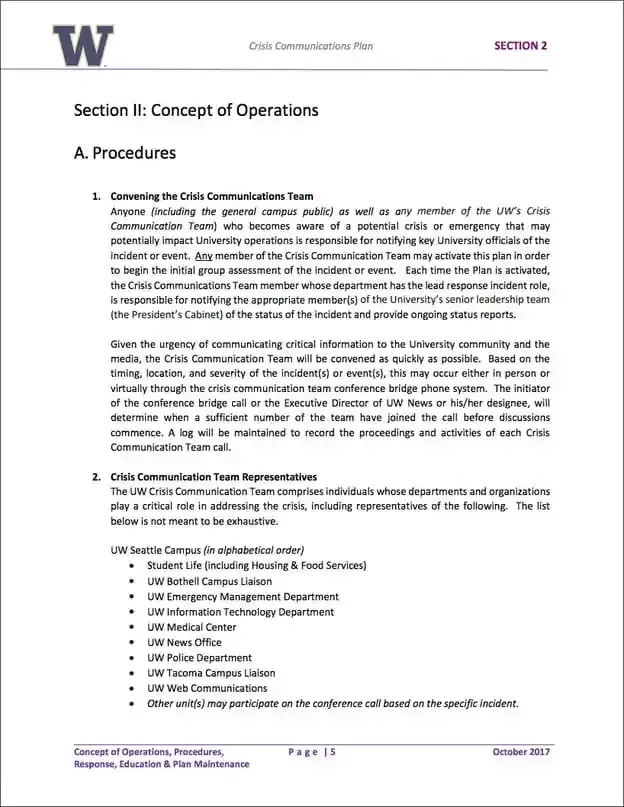
The University of Washington has an extensive crisis communication plan geared toward preserving the safety and security of community members.
As a university, the main audiences for communication include students, faculty, staff, parents, and alumni, as well as visitors, temporary residents, the general public, and the media.
What I like: The attention to detail in all the varied organizations included in the team of representatives shows an added layer of consideration during a crisis. Having a list of reps at hand guarantees a proper and timely response.
2. Southwest Airlines
Southwest has consistently been one of the safest airlines in the world. However, that doesn‘t mean the company doesn’t experience accidents.
On Flight 1380, an engine malfunction resulted in the death of a passenger and was recorded as the company‘s first in-flight fatality. The company’s CEO, Gary Kelly, immediately responded to the situation by offering a sincere, heartfelt apology to the victim's family. He then pulled all advertising from their social media channels and made personal phone calls to passengers offering support and counseling resources.
Why this was effective: Although crises like these are hard to imagine, they do occur and have a significant impact on businesses. Despite Southwest‘s lack of prior experience with such an accident, the CEO exhibited readiness for the situation and displayed genuine regret through his statements and the company’s actions.
3. Boeing
Boeing experienced a major crisis when two of its 737 Max airplanes fatally crashed in Indonesia and Ethiopia just five months apart in 2018 and 2019. The crashes killed a combined 346 people and the manufacturer is still suffering the fallout from the events.
At first, Boeing blamed pilot error for the crashes until information surfaced later that it was a flight control software issue. In response, the FAA and other global regulators grounded all Boeing 737 Max planes for 20 months until they could figure out what software glitch was causing the fatal crashes.
As a result, Boeing's stock price plummeted, and it was forced to halt production of the Boeing 737 Max, costing the company billions in losses. Once the pandemic hit in 2020 and air travel slowed, Boeing faced another crisis as orders for the model were canceled, leading to more financial losses.
To make matters worse, when the 737 Max planes were finally cleared to fly in November 2020, they were grounded again in early 2021 after electrical issues were discovered. In 2021, Boeing was ordered to pay $2.5 billion to settle charges that the company hid issues with the plane from safety officials.
At first, Boeing deflected blame for the crashes to "inexperienced pilots," but an investigation later showed that Boeing's flight control software was the main contributor to the crash. Moreover, the US Justice Department found that Boeing knew about the software issue and tried to conceal the faulty software from investigators.
“Boeing's employees chose the path of profit over candor by concealing material information from the FAA concerning the operation of its 737 Max airplane and engaging in an effort to cover up their deception,” stated a DOJ press release regarding Boeing's fraud charges.
While nothing would have made up for the loss of life, Boeing would have been better off coming clean about the existing software glitch. Its efforts to conceal the issue meant that pilot training manuals lacked information about the faulty system, which forced planes to nosedive after it overrode pilot commands.
What could've been better: Had Boeing been transparent about its automated flight control system, including it in its manual and informing customers of the aircraft software, tragedy could have been prevented.
4. Virginia Department of Education
Similar to universities, schools need to deal with crises efficiently, especially if they impact the normal class schedule. Since schools deal with children, parents and guardians must be made aware of any situations that could affect their children's education, safety, or health.
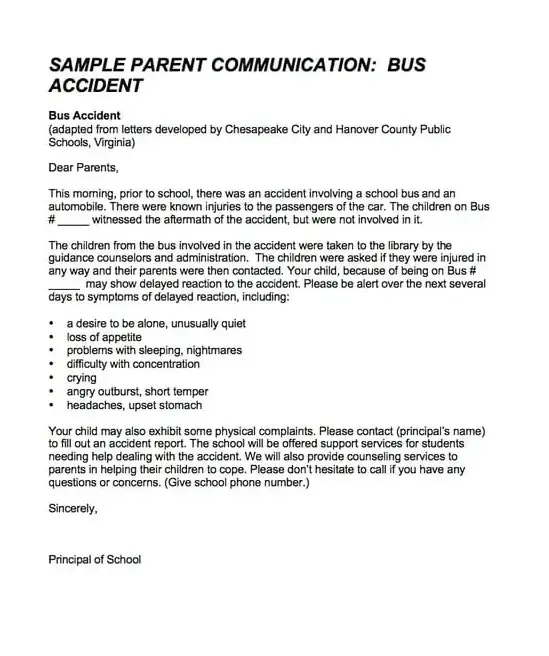
The Virginia Department of Education has created a lengthy management plan, including crisis communications. The plan highlights various crises that would require communication with parents — such as a school bus accident —and gives letter templates that can be quickly sent out.
What I like: This crisis communication plan lists several different types of symptoms that parents or guardians are instructed to watch out for. This is vital because it isn't always clear how students are affected, and it is important for their care to know what to look out for.
5. KFC
In 2018, restaurant chain KFC got into an awkward situation when it ran out of chicken to serve its customers. Having built its brand on its 11-spice fried chicken recipe, this was a crisis that the company probably didn't plan for.
But, KFC‘s marketing team quickly got to work and was able to put a positive spin on the situation. They released videos and tweets like the one below that light-heartedly apologized for the shortage and showed off the brand’s humility.
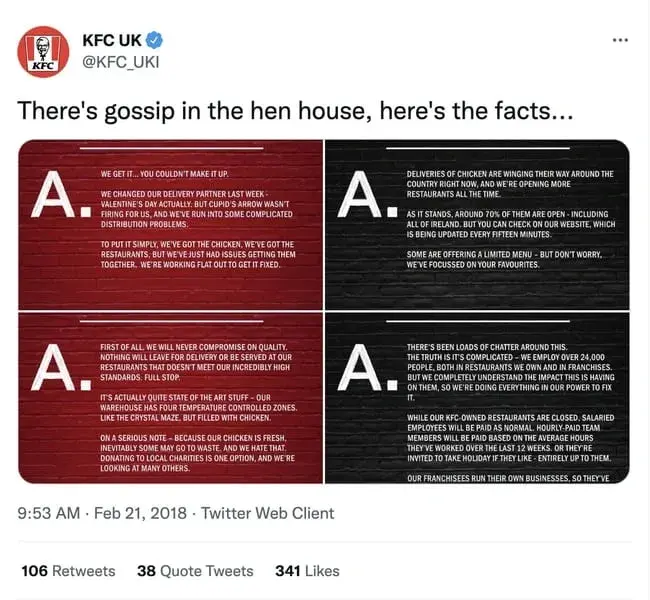
This is why a crisis communication plan is essential for restaurants. Some scenarios you'll want to plan for are the spread of foodborne illness, unsanitary working conditions, and, of course, delivery issues affecting food supply.
What I like: While the brand typically doesn't take itself too seriously (like its humorous social media marketing campaigns), it presented customers with the facts and explained what it was going to do to better serve them.
6. Amazon
Amazon faced criticism in December 2021 after a tornado ravaged one of its warehouses in Edwardsville, Illinois. Six people died in the warehouse collapse in Illinois as a series of tornadoes ripped through parts of Tennessee, Kentucky, and Arkansas.
Once reports surfaced of Amazon warehouse workers allegedly being forced to continue working through tornado warnings, the company's health and safety guidelines quickly came under scrutiny.
Amazon's first misstep was a delayed public response. CEO Jeff Bezos took nearly 24 hours to respond to the warehouse collapse.
“The news from Edwardsville is tragic. We're heartbroken over the loss of our teammates there, and our thoughts and prayers are with their families and loved ones”, Bezos tweeted. “All of Edwardsville should know that the Amazon team is committed to supporting them and will be by their side through this crisis. We extend our fullest gratitude to all the incredible first responders who have worked so tirelessly at the site.”
Bezos was quickly lambasted across social media, with many suggesting that his statement was insincere.
What could've been better: When such a tragic loss of life happens, it‘s best to come out with a statement that expresses empathy sooner rather than later. Bezos’ reply came across as insincere in part because it was delayed. The CEO had been steadily tweeting and posting about the landing of Blue Origin throughout the day, so by the time he commented on the tornado tragedy, it seemed like an afterthought.
7. Burger King
In the fall of 2019, a man who follows a vegan lifestyle filed a lawsuit against popular fast food chain Burger King on the basis that the company misled other vegan customers regarding the newly introduced Impossible Burger. Upon realizing the meatless patties were prepared on the same grill as the 100% beef burgers, the plaintiff alleged that the ads weren't clear that the burger was not completely meat-free.
Other popular fast-food chains like Subway and Wendy's have experienced similar crises in the past regarding issues with food preparation. Although both were unfounded claims, they caused a significant crisis for both brands. It's not a surprise that Burger King experienced similar, unfounded claims.
Although Burger King had a strong rebuttal against the lawsuit, the company awaited the decision of the judge who dismissed the case a year later due to a lack of evidence from the plaintiffs.
Why this was effective: Burger King was successful in this crisis communication because it allowed the crisis to run its course without intervening more than necessary. At the announcement of the case dismissal, Burger King responded, “This claim has no basis.”
8. United Airlines
No list of crisis communication examples would be complete without mentioning United Airlines. Already under pressure for less-than-stellar customer service, the 2017 video of Dr. David Dao being dragged out of his seat when the airline overbooked put United into a tailspin.
Their first response? Not great. United's CEO tried to blame Dao, calling him “belligerent” and “disruptive.”
Not surprisingly, this didn't sit well with the public, and #boycottUnited hashtags began trending. The company then did an about-face, took full responsibility, and pointed to changes being made.
What could've been better: Businesses should lead with empathy in situations where emotions run high. While United's image did stabilize over time, the changed tactics strategy is a good example of what not to do when a crisis comes up.
9. Hollywood Foreign Press Association
In 2021, the Hollywood Foreign Press Association was under fire for its lack of diversity and inclusion. Over 100 PR firms — and their celebrity clients — threatened to boycott the Golden Globes unless the HFPA committed to “transformational change” within the organization.
“We call on the Hollywood Foreign Press Assn. to swiftly manifest profound and lasting change to eradicate the longstanding exclusionary ethos and pervasive practice of discriminatory behavior, unprofessionalism, ethical impropriety, and alleged financial corruption endemic to the HFPA, funded by Dick Clark Productions, MRC, NBCUniversal and Comcast,” the publicists said in a statement.
“To reflect how urgent and necessary we feel this work is, we cannot advocate for our clients to participate in HFPA events or interviews as we await your explicit plans and timeline for transformational change."
In response to the outcry, the HFPA pledged to increase its membership to a minimum of 100 people and to require at least 13% of its members to be Black journalists.
While the HFPA has since implemented several changes, including increasing membership to 105 members, the organization still has a lot of work to do in order to regain the trust of the entertainment industry. Not only was the Golden Globes ceremony telecast canceled in 2022, but many publicists maintained their position on having their clients boycott the organization.
What could've been better: Had the HFPA listened to concerns and implemented change sooner, it might have been met with less scrutiny.
10. Cracker Barrel
In 2017, a man named Bradley Reid asked a question on Cracker Barrel's corporate website: He wanted to know why his wife had been let go from her 11-year manager position at one of the company's Indiana locations.
The social media firestorm came quickly, with #JusticeForBradsWife trending and other brands posting signs that they would be happy to hire Brad's wife.

Cracker Barrel‘s response? Silence. The public never learned the circumstances of Brad’s wife's job loss, and after a few months the crisis blew over.
In this case, weathering the storm worked for Cracker Barrel, in part because the issue revolved around a single person and their specific circumstances.
Speaking up — even if the job loss was benign — could have resulted in questions about personal privacy and also put the company on the defensive. Instead, they chose to wait out the storm.
Putting It All Together: Making Theory Work in Practice
After months of researching and analyzing crisis communication strategies, one truth stands out: no company is immune to a crisis, but every company can be prepared.
After reading dozens of case studies and expert interviews, I’ve discovered that the difference between a crisis that strengthens a brand and one that damages it often comes down to preparation and humanity.
What struck me most was how the best crisis communicators emphasize that crisis management is fundamentally about people.
Whether analyzing KFC‘s chicken shortage or Boeing’s 737 Max crisis, I found that the companies that handled crises best weren‘t those with the biggest PR teams – they were the ones that had clear plans, spoke with authentic voices, and weren’t afraid to admit mistakes.
The most powerful insight I gained? A crisis, when handled well, can actually strengthen stakeholder trust.
Through this research, I‘m convinced that crisis communication isn’t just about damage control – it‘s about demonstrating your company’s values when they matter most. I hope this guide helps you build a crisis communication plan that reflects your organization's best self, even in its most challenging moments.
Editor's note: This article was originally published in May 2019 and has since been updated for comprehensiveness.
Public Relations
.png?width=112&height=112&name=Image%20Hackathon%20%E2%80%93%20Vertical%20(8).png)

.png)
